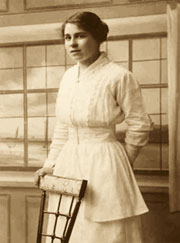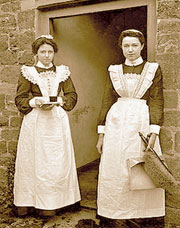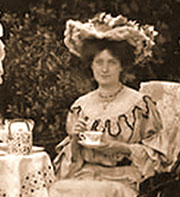Learn how to implement Pinterest Rich Pins on your website. I have hundreds of Byzanatine and Russian history images on Pinterest.
Serving Afternoon Tea
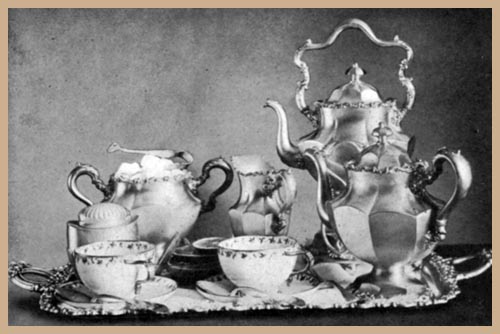 Above: Tea Service
Above: Tea Service
In most houses, where a butler or parlor maid is employed, and in many houses where a cook and waitress make up the staff of employees, afternoon tea is a simple and every-day occurrence. Occasionally no one outside the family may happen in, but tea is served just the same. Tiny sweet wafers or cakes or plain bread-and-butter sandwiches with tea are usually all that is provided at this hour; still there are hostesses who vary the items from day to day, or occasionally. Hot bouillon with bread sticks or buttered rolls, hot toasted muffins or cassava cakes, nut, cress, or fanciful, sweet sandwiches, and a dish of bonbons are among the tidbits served in some houses. The cook assists in the preparation of some of these articles, but the waitress, no butler being employed, is responsible for the freshness of the tea, the temperature of the bouillon, tea, and hot muffins.
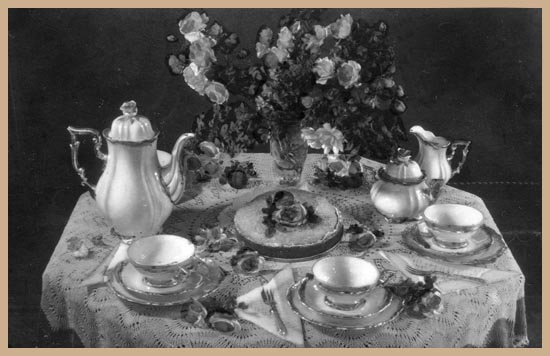 For carrying out the hospitality expressed in this custom, a nest of tea-tables and a "curate" or English basket-tray are of great convenience. These articles are very light and sometimes exceptionally pretty ; the tables are often of highly polished mahogany and inlaid with pearl. The basket-tray ("curate") consists of a tripod to which three hoops are fastened one above another, and some distance apart; into each of the hoops is set a plate holding the articles to be served. The framework is of mahogany, bamboo, or other light wood, and the whole is carried about the room by a handle at the top. The other accessories to afternoon tea are:
For carrying out the hospitality expressed in this custom, a nest of tea-tables and a "curate" or English basket-tray are of great convenience. These articles are very light and sometimes exceptionally pretty ; the tables are often of highly polished mahogany and inlaid with pearl. The basket-tray ("curate") consists of a tripod to which three hoops are fastened one above another, and some distance apart; into each of the hoops is set a plate holding the articles to be served. The framework is of mahogany, bamboo, or other light wood, and the whole is carried about the room by a handle at the top. The other accessories to afternoon tea are:
- Tea cloths for the tables.
- Small fringed napkins for the guests.
- Doilies for the bread and cake trays or baskets.
- A small tray covered with a doily for the waitress.
- A tray holding two or three small tea cups and saucers, teaspoons of small size, small sugar bowl with sugar and tongs, small cream pitcher of cream, and a pretty dish holding thin slices of lemon.
- A teapot of fresh-made tea, or a teapot of boiling water, a tea caddy with tea, spoon for the caddy, a silver tea ball or a china percolater, and a teakettle filled with fresh boiling water.
- A bouillon urn.
- Bouillon cups.
- Bouillon spoons.
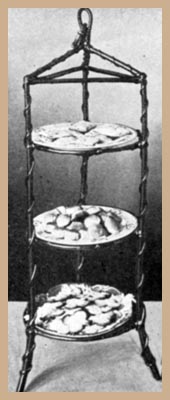 Shortly after three o'clock the ever prompt waitress has the tea-tray with its glistening china and silver and the basket-tray of edibles in readiness; the teakettle is singing over the low-turned jet of the gas range and the waitress herself is in immaculate trim from the tiny cap on her neatly brushed hair to the soft-soled shoes on her feet.
Shortly after three o'clock the ever prompt waitress has the tea-tray with its glistening china and silver and the basket-tray of edibles in readiness; the teakettle is singing over the low-turned jet of the gas range and the waitress herself is in immaculate trim from the tiny cap on her neatly brushed hair to the soft-soled shoes on her feet.
Left: English Basket Tray or "Curate"
She may or may not answer the bell and admit such callers as come; this depends upon the number of employees.
After the hostess has greeted one or more guests, the waitress sets a pot of tea to brew, noiselessly brings in one of the larger tables from the "nest" and sets it in an inconspicuous place in the drawing-room. Upon this she disposes such articles as will crowd the table of her mistress. Here also she sets the bouillon urn, with cups and spoons, when bouillon is provided. The outer and handsomest table of the nest she now sets before the hostess, spreads a cloth over it, and brings in the tea-tray to set down upon it. She now returns for the pot of tea, which was set to brew, and her tray. After a cup of tea is poured she passes it on her tray, with two or three napkins beside the cup, to the one for whom it is prepared, then brings in the basket-tray of edibles, and passes this and other cups of tea or bouillon as desired. In the meantime she keeps a sharp lookout and removes cups or replenishes them with tea as is needed. Or, she passes cream and sugar or slices of lemon, takes out the spent teapot, and brings in a fresh supply of tea or slices of lemon, etc. All this sounds arduous, but in reality, in houses where the maids are limited in number the callers of an afternoon are not numerically strong, and a sister, daughter, or friend of the hostess is usually present to help out.
